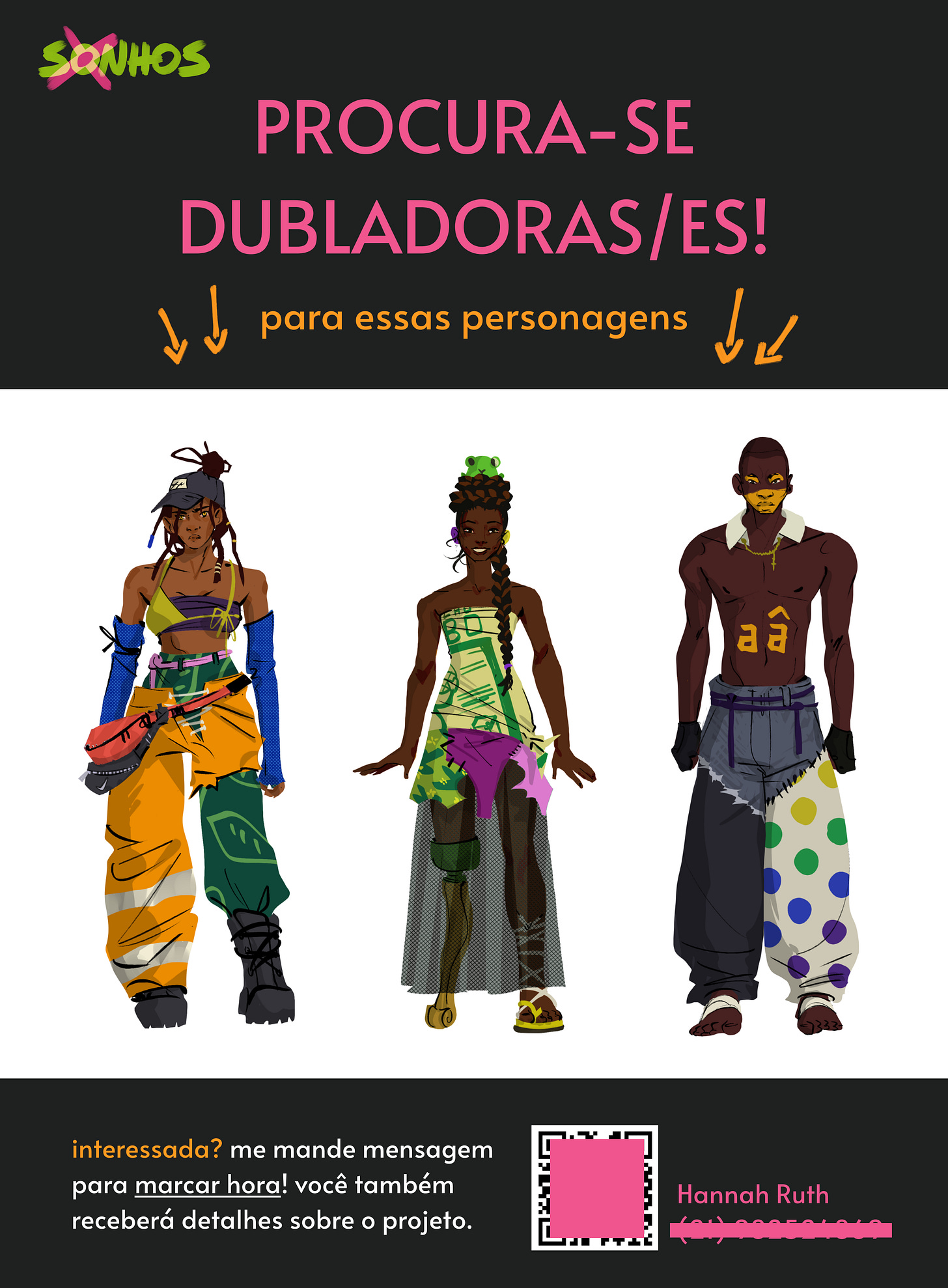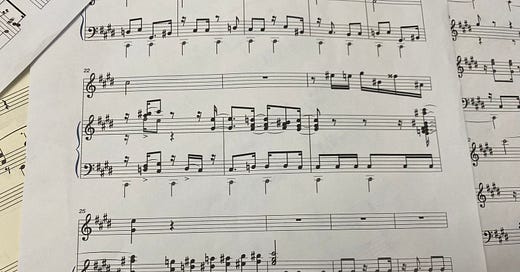Log
Project SONHOS
Time in production 32 weeks and 3 days
Status Production (rough animation)
Today I will talk about an area I have very little expertise in, sound, so this part of the process is really about all the people I’m collaborating with: For the section about the soundtrack in this post I invited my friends and composers for this project to write about their experience!
Voice actors
The search for voice actors started in the subway, not long after the idea for this project was born, when a street rapper performed her improv to us passengers. Her lines and her voice left an impression on me, and very shily, the idea of asking her to be Tapioca’s voice creeped into my mind.
Gathering the courage to ask this stranger to help me with my random college project was hard, but now actually making it work is also hard. Me and the artist talked about the project, she showed interest, but the situation was complicated and unfortunately I wasn’t able to collaborate with her in the end. However, thankfully another candidate for Tapioca’s voice is secured. After being crazy and asking a stranger to voice act, I went through the process of a classic audition.
I created a poster to hang around the campus. The poster just had a simple call out, my number, and the designs of the main characters, because I wanted to attract people who resonated with them and the aesthetic. Once I started receiving messages about the ad, I had formal replies ready to copy-paste, as I wanted to appear as professional as possible. People received the premise of the project, a reminder that this is not a paid opportunity, and the choice of which character they wanted to make a test for, plus a little description about the character. The test itself was simply them sending an audio file to my whatsapp, saying a line specifically created for the test. If they seemed reasonably competent and had a fitting voice, I asked them to come record in the college sound studio. I received 20 messages in total, which is a great success to me!

Recording itself varied depending on the person, some needed very little guidance, and some did better with more direction. I wish I could have done all the recordings in one go, but I could not find all the voice actors in time (including Tapioca) before the first semester ended, so I had to wait out the summer break to finish the process.
The Score
I invited my friends and composers, Enzo Bloise and Leo Garritano, to write about their experience working on this project. Their work together was super interesting, because one comes from a background of classical music training, while the other is producing in the pop/DJ industry. I feel incredibly lucky to know them, introduced to me by my partner, as without them I would have depended on pre-made music. With them, I could create an original concept for the score and make it part of this aesthetic exploration.
A very welcome challenge - that’s how I’d define this briefing. Hannah’s vision for the soundtrack came across as something so innovative it was impossible not to feel compelled to tackle it. A marriage between root brazilian rhythms and genres with EDM, techno, cyberpunk-ish sound aesthetics is, from all angles, a very exciting idea.
Leo Garritano and I spent months working to figure out how we’d translate so many timbres to bridge the sonic gap between the genres. We had to determine what was the core identity of each genre – that being what made samba samba, for instance. This is because we did not want to simply sample instantly recognizable samba vocals and beats on top of an electronic dance instrumental, we wanted to intertwine the DNA of both movements. That way we were able to carve out the excess and fill in the blanks with all the elements that would be responsible for creating this hybrid genre. The - as we began to call it early on in the process - “sambapunk”.
Luckily, hybridizing brazilian music with electronic music is currently becoming more and more of a trend in many underground brazilian niches, so we didn’t exactly lack references. Nevertheless, fiddling with samba was very new. Our goal was to keep a recognizable sound by preserving the personality of many signature percussion instruments and the overall BPM seen on most samba songs whilst utilizing synths to emulate the post-apocalyptic, dystopian-yet-tropical vibes Hannah was going for. That amounted to a mixing and mastering nightmare that was equally intimidating and rewarding to overcome for me, as a music producer, and for Leo, as a musician and composer just as much. Truly, the greatest gift from working on it was just how much we were allowed to explore and learn in our very free creative process.
From Hannah’s description given to us, I tried to think of a theme that includes the apocalyptic hostility, and at the same time refers to typical rhythms from brazilian music. The theme was build on the most common rhythms of samba, so it could be easily recognizable. To bring in the necessary hostility, I worked with dissonance and symmetric scales, which create a feeling of desperation and anxiety, commonly used by composers from the 20th century. I embraced classic elements from samba, like the instrument Surdo (de primeira), using it throughout the whole score to create the feeling of obssession to favor the sensation of discomfort and danger, additionally to other percussive elements and eletronic timbers to emphasize de merge between samba and the futuristic-apocalyptic universe of SONHOS.
Giving the animatic sound
Traditionally, sound effects are recorded in real-life, but for the animatic I used pre-recorded sounds I found online. And not only that, I stole them! For the animatic only, of course. My intention is to look for high-quality, official sound effects for the final film, additionally to any self-recorded sounds I can do. But I didn’t spend the time doing that for the animatic because, aside from having little time, the sounds need to be precisely timed with the animation, which I didn’t have yet, and the animatic is not supposed to be public (or commercial) anyway.
The soundscape I created for the animatic had the objective of creating the right mood and transmitting a certain depth to the world. That’s why I also added a sketch version of the soundtrack Enzo and Leo were composing, and temporary voice lines that the actors recorded from their phones. First, I was scared a shitty soundscape would ruin the animatic, but it improved it so much compared to silence. Music and dialogue all impact the first impression over the work, and since this project is all about the aesthetic experience, they were essential.
It was crazy to find and match sounds to all the vehicles - different types of engines, movements, proximity to the camera. But it’s the mix of sounds that really makes it feel realistic. Luckily, last semester I took a class on sound mixing, so I can deal with the basic concepts needed for something to sound acceptable. I definitely want to learn more about foley, mixing, composing, it’s all so new and exciting to me but I see how much it adds to the animation - to cinema!
Up next
Next issue I will lay out all the tangential things I had to create before starting the actual production process, like character sheets, the color script, environment designs, and how I tried not to use them as procrastination to move forward.
Have a magical day!





